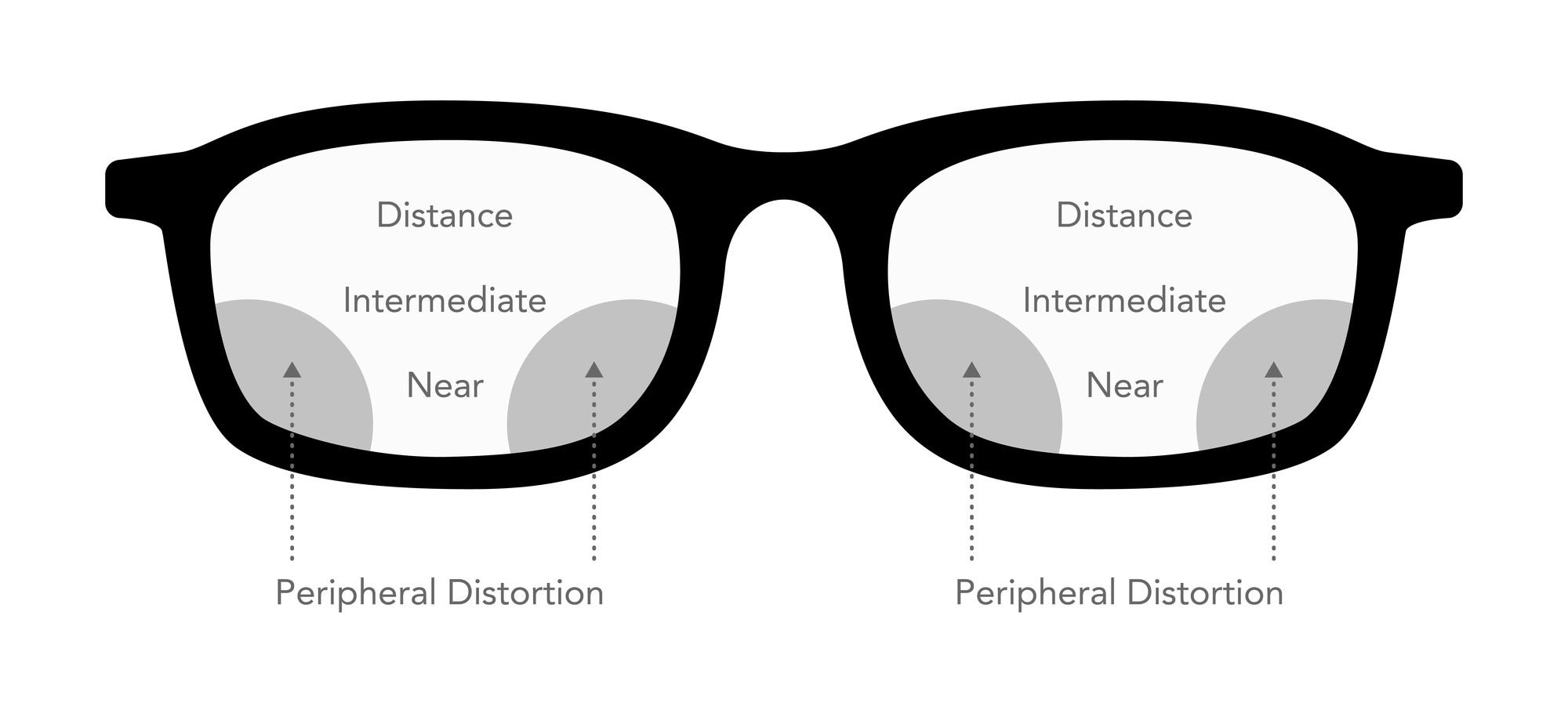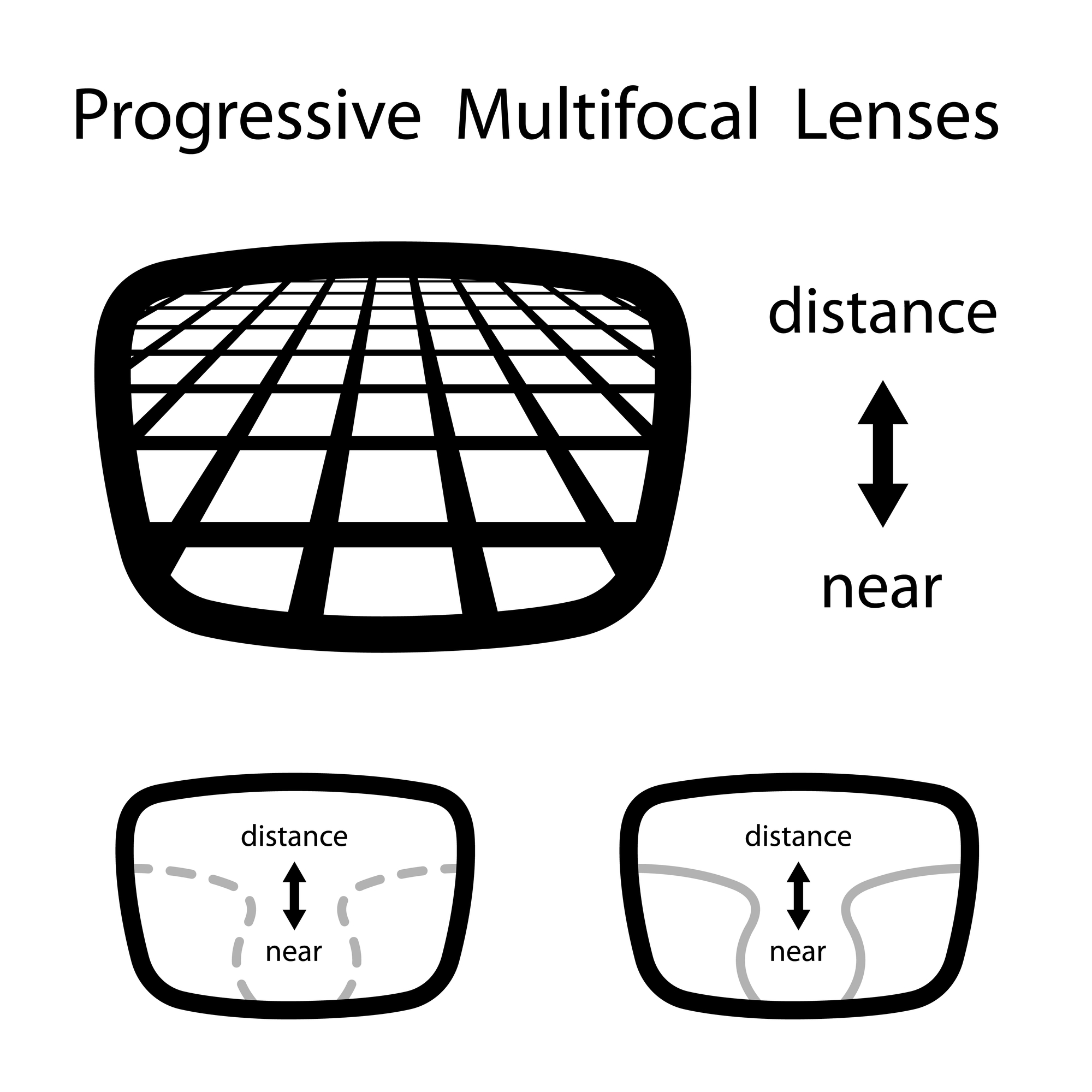Updated on October 9, 2024
Progressive Lenses


Vision Center is funded by our readers. We may earn commissions if you purchase something via one of our links.
If you have a refractive error that causes blurry vision at near and far distances, your eye doctor may recommend progressive glasses for clear vision. But did you know there are many types of progressive lenses?
This article covers the different types of progressive lenses, including how they work compared to other lenses, and tips for choosing the best type for you.
What are Progressive Lenses?
Progressive lenses are multifocal lenses that correct near, far, and middle vision. There’s a seamless transition in magnification from top to bottom.

A progressive lens has three sections. Unlike bifocal and trifocal glasses, progressive lenses differ in that no visible line separates the sections. The prescription changes across the lens, so you can see at all distances clearly with a single pair of glasses.7
Where to Buy Glasses + Contacts
Best Overall: Warby Parker
Fastest Delivery: EyeBuyDirect
Also Great: Liingo
Best Place to Buy Contacts: Discount Contacts
How Progressive Lenses Work

Progressive lenses change slightly in prescription throughout the lens. This makes for a smooth, gradual shift instead of a harsh difference in section.
With progressive lenses, you look through the top section of the lens to see things that are far away. The middle section of the lenses clarifies objects in the middle ground. The bottom section helps you see objects that are close up.
What Are the Different Types of Progressive Lenses?
Many different types of progressive lenses cater to various needs. These include:
Standard Progressive Lenses
These are also known as regular progressive lenses because they work for most people. Standard progressive lenses are the most basic option and tend to cost less than specialized progressives.
One downside of standard progressive lenses is that they require larger frames for a smooth transition between prescription strengths. However, the size provides a relatively wide reading area.
Computer Progressive Lenses
Computer progressive lenses are also called near-variable focus lenses or office lenses. They’re designed to reduce visual fatigue (computer vision syndrome) for people who use a computer for more than four hours daily.
However, computer progressive lenses aren’t only for office workers. They can help anyone who needs clear vision from 16 inches to 6 feet. These include dentists, artists, and hairdressers.
Short Corridor Progressive Lenses
Short corridor progressive lenses are ideal for people who prefer smaller frames. However, the improvement in fashion often requires some sacrifice in practicality.
One downside of short corridor progressive lenses is that the smaller frame reduces the reading area. Some people find it difficult to adjust to this lens design. Additionally, they cost more than standard progressive lenses.
Transition Progressive Lenses
You may already be familiar with transition lenses on single-vision glasses. They’re a brand of photochromatic lenses that automatically darken when exposed to ultraviolet light. Now, they’re available on progressive glasses as well.
Transition lenses allow you to wear one pair of glasses indoors and outside. There’s no need to swap between eyeglasses and prescription sunglasses.
Premium Progressive Lenses
Premium progressive lenses are highly customized to your individual needs, including:
- Prescription
- Chosen frames
- Eye anatomy
- Your dominant eye
Premium progressive lenses are designed with computerized wavefront technology. They typically provide better vision than other options due to the vast, distortion-free reading area. However, they cost significantly more than other progressive lenses.
Ground-View Progressive Lenses
These progressive lenses are great for golfers and anyone who needs to see clearly when looking down. Ground-view progressive lenses provide better vision along the bottom and sides of the lens.
They use patented technology to reduce lens distortions, giving you a ground view that closely mimics natural vision.
Who Should Use Progressive Lenses?
The best way to determine if progressive lenses are right for you is to schedule an eye exam with your doctor. They may recommend progressive lenses if you have near and distant vision trouble.
You might need progressive lenses for a variety of reasons. Some of these include:
- As you get older, your eyes change, and your reading vision declines (presbyopia)
- You spend a lot of time reading small fonts or staring at a computer screen, which can take a toll on your natural vision
- You have trouble reading fine print, big street signs, or other things
If you have astigmatism, progressive lenses may be for you. People who have astigmatism may have both nearsightedness and farsightedness.1
Pros and Cons of Progressive Lenses
Like all types of lenses, there are pros and cons of progressive lenses:
Pros
Here are a few benefits of progressive lenses:7
- Improve vision at all distances in a single lens
- Have various lens powers (multifocal lenses)
- Offer a seamless transition without a noticeable line
- You don’t need to purchase multiple pairs of glasses for different vision issues
- Help you save money since you only need one pair
- Help you see clearly
Cons
Here are a few downsides of progressive lenses:7
- Require you to look at a specific part of the lens to see clearly at different distances
- Can be expensive (since they correct multiple types of vision problems)
- Can take time to get used to
- Any type of glasses can cause some peripheral distortion
Tips for Adjusting to Progressive Lenses
Getting used to wearing progressive lenses may take some time, like all corrective lenses. This is especially true if you are not used to wearing glasses.
It can take weeks or even months to get used to wearing progressive reading glasses. Here are some tips for adjusting to progressive lenses:
- Wear your eyeglasses often
- Pick glasses that you like wearing and feel confident in
- Get a pair of glasses that fit properly
- Have your lenses professionally fitted
- Take breaks from wearing your progressive lenses if you develop headaches, eye strain, or eye fatigue
If your eyes never adjust to your new glasses or are causing you more harm than good, consult your doctor. Progressive eyewear is not for everyone. There may be another option that is better for you.
How Much Do Progressive Lenses Cost?
Glasses themselves can be costly. Prices range from about $8 to upwards of $600 for people who don’t have vision insurance.3
Your vision insurance may or may not cover the cost of prescription glasses. Some insurance plans may pay up to a certain amount.
How much your glasses cost you depends on a few factors:
- Where you buy them (your geographic location)
- From whom you buy them (an eye doctor, an eyewear store, online, etc.)
- The brand of glasses you buy
- The materials you choose
- The lens type you choose (progressive lenses tend to be more expensive)
- Any add-ons that you decide to purchase
For example, a progressive lens starts at $295 at Warby Parker. Premium progressive lenses may cost more.6
Summary
Progressive lenses create clear vision at all distances. Unlike traditional bifocals and trifocals, a progressive lens has no visible lines, making for a smooth transition.
There are many different types of progressive lenses, including standard progressive lenses, premium progressive lenses, and computer progressive lenses.
Wearing progressive lenses may come with a learning curve. They can also cost significantly more than regular glasses. These lenses are not for everyone (other options like single-vision lenses and bifocals are also available).
In this article
7 sources cited
Updated on October 9, 2024
Updated on October 9, 2024
About Our Contributors
AnnaMarie, a staff writer for Vision Center, specializes in ophthalmology, optometry, and basic optic procedures, as well as preventative eye care. With a B.A. in Journalism & New Media and minors in Creative Writing and Women, Gender & Sexuality Studies from Gettysburg College, her goal is to enhance readers' understanding of eye health. She covers a wide range of topics, from selecting the right eyeglasses and contacts to managing and preventing eye diseases, and exploring vision correction surgeries.
Dr. Melody Huang is an optometrist and freelance health writer with a passion for educating people about eye health. With her unique blend of clinical expertise and writing skills, Dr. Huang seeks to guide individuals towards healthier and happier lives. Her interests extend to Eastern medicine and integrative healthcare approaches. Outside of work, she enjoys exploring new skincare products, experimenting with food recipes, and spending time with her adopted cats.






